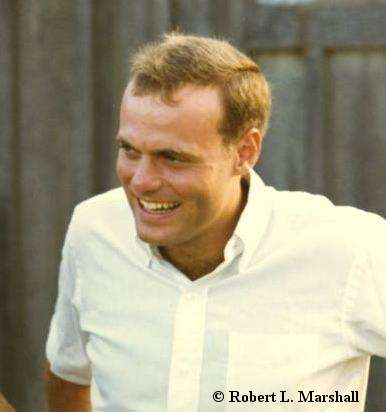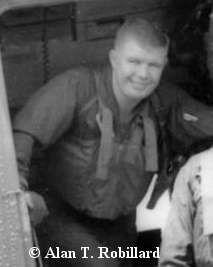
Harold B. "Hank" Lamb |

John R. Whitlow |
On the 24th of October 1969 a flight of six (or 8) CH-46's had received a fragmentary order to insert a strike force of Marines into an area known as the "Antenna Valley." LtCol. Charles R. Dunbaugh, the Commanding Officer, was leading the flight and I was flying in the number two position on his wing. The flight was briefed in the usual manner and all aircraft departed for the pick up zone which was somewhere north of LZ Baldy as I remember.
Upon arriving at the embarkation LZ all was in order. The LZ was sufficiently large enough to accommodate all aircraft to land at one time. The Helicopter Support Teams (HST), with their yellow vests for identification purposes, had each helo team of combat loaded Marines lined up for efficient and speedy boarding. The flight was in the LZ for no more than a few minutes when all of the first wave of troops were on board and the flight was cleared to depart.
The flight to the southwest was uneventful until we arrived at the insert area. Here the flight of accompanying Cobra gun ships (number unknown but more than two) had been cleared to prep the zone prior to the H-46's landing. This prepping of the zone consisted of raking it with fire and was not always allowed. Most of the time we had to go into LZ in a "guns cold" mode. Normally were only allowed to fire if we saw the muzzle flashes of the enemy shooting at us or heard the phling - phling of a round coming in one side of the aircraft and out the other. In either of the above cases we could then return fire.
The Cobras completed their zone prep and cleared the flight into the zone. It also was large enough to accommodate the entire flight to land at one time. We were not the only force in the area which was soon evident as we began to receive fire from the Viet Cong in the vicinity. When all the aircraft had off loaded their strike force Marines, the flight lifted out and headed back to the original pick up zone for another assault element of Marines.
As was the case of the first loading of troops, the HST personnel had combat ready helo teams organized for another speedy loading to bring additional fire power to those first troops inserted in the "Antenna Valley" and engaged with an enemy force.
Upon returning to the insert zone fire was again received during the approach and while in the zone unloading the troops. One round struck our aircraft with a resounding Thud, unlike the phling - phling, and that round sent a recognizable vibration through the aircraft. It had hit something more resistant than the thin aluminum skin. A quick survey of the instruments confirmed that nothing vital to flight had been damaged. About this time the following comment came over the FM radio from the last aircraft to land in the zone, "Swift Six, they won't get out of my bird!" LtCol. Dunbaugh's return comment was, "They won't do what? We'll sort it out later, we've got to get the hell out of here right now!"
The flight lifted and headed toward An Hoa combat support base for refueling. LtCol. Dunbaugh's aircraft made a much faster than normal approach to the marston matting landing pad adjacent to the hot point refueling outlets. He touched down some 50 feet from the first refueling position, slammed on the brakes and slid to a halt. Within seconds LtCol. Dunbaugh was out of the cockpit and headed back toward the last helo in the flight to determine what was wrong. This time, as at other times when the CO was upset, the blood vessels were giving off a distinct red blush to LtCol Dunbaugh's face. Several minutes passed, all the aircraft were refueled, and looking back over my right shoulder I saw Col. Dunbaugh headed back to his helicopter with a smile on his face and I could read his lips saying, "I'll tell you later."
Back in the ready room for the debriefing we found
out what had happened. Some how the HST personnel had made a mistake
in the pick up zone. One helo team which was loaded aboard the last
aircraft was composed of routine medevacs, end-of-tour Marines and those
Marines who were ready to go on R&R. Many of them did not even
have weapons with them. I guess rightly so, they were not about to
get out of that helicopter into a hot fire fight. It did disprove
one strongly felt position of the Grunts however. Until then they
seemed to have the opinion that if a helicopter lands you should get on
board because it is probably going to a place much more desirable than
where you currently are.
I can offer some further incite into the "They Won't Get Out of My Bird" adventure. Yes, that did happen on my aircraft. The date was either 24 or 31 October 1969. 1stLt. John R. Whitlow was my copilot. I reviewed my logbook and those are the only possible dates. As noted in your narrative, I was tail end Charlie in the flight. On our first approach I was probably a little hot and certainly heavy with a load of combat troops. I waved off and made a 360 degree turn and came back into the LZ which by then had been vacated by the other aircraft. We had plenty of room to land but we were also the only target! Of course, the aerial gunners loved it but I was greatly relieved to escape unscathed.
We quickly rejoined the flight enroute to Baldy to pick up the next wave. Perhaps because of the unusual experience with the first wave, we just didn't pay particular attention while loading the second wave. My second approach was more conservative, and we were able to land in the LZ along with the rest of the flight. Even though we were taking fire it was comforting to be in the LZ with other aircraft. Then came the crew chief's remark that no one was leaving the aircraft. Unfortunately, I don't recall any more details of my conversation with the crew chief or with LtCol. Dunbaugh. It was just of those bizarre moments where you simply don't understand what's happening. At some point, I looked back into the cabin for the first time. I was indeed surprised to see this "assault force" sitting on the cloth benches with soft covers, dark glasses, manila envelopes, and sea bags. Fortunately, Lt. Whitlow interrupted the catalepsy of the moment with his typical candor by suggesting that we leave quickly as we were, once again, the only aircraft in the LZ. On the way back to Baldy, I asked the crew chief if he thought our passengers seemed out of touch with their mission. He thought they looked a little "casual" but hadn't given it much thought.
Except for the fact that we took fire again on the third landing in the LZ, nothing unusual happened.
Hank Lamb
Editorial comment; The linked
After Action Report (AA) shows only the pilot and copilot. I have
never seen an AA which did not name the entire crew. My assumption
is that LtCol. Dunbaugh directed Lt. Lamb to not place the crew chief nor
the gunners on this report, thereby not giving them credit towards Air
Medal Strike/Flight awards. Why? Seems to me that someone in
the rear of the aircraft should have notified the pilots of the unusual
dress of these "assault troops" and the fact that they were not carrying
weapons when the aircraft was once again headed into a hot LZ.

Harold B. "Hank" Lamb |

John R. Whitlow |
Information provided by:
Franklin A. Gulledge, Jr., Major,
USMC (Ret)
Harold B. "Hank" Lamb, 1stLt.,
USMC (Vet)
1stLt. Harold B. Lamb's History Index
Maj. Franklin A. Gulledge's History Index
Back Browser or History Index or Home
-